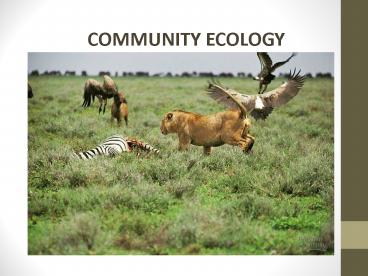COMMUNITY ECOLOGY - PowerPoint PPT Presentation
1 / 19
Title:
COMMUNITY ECOLOGY
Description:
COMMUNITY ECOLOGY OBJECTIVES: Describe types of relationships among organisms. Compare primary and secondary succession. Community Interactions Community = a group of ... – PowerPoint PPT presentation
Number of Views:666
Avg rating:3.0/5.0
Title: COMMUNITY ECOLOGY
1
- COMMUNITY ECOLOGY
2
OBJECTIVES
- Describe types of relationships among organisms.
- Compare primary and secondary succession.
3
Community Interactions
- Community a group of populations of different
species living close enough to interact. - Types of Interactions
- Competition,
- Predation,
- Symbiosis.
4
Competition
- The competitive exclusion principle states that
when two species compete for the same resource or
niche, eventually the one with the slight
reproductive advantage will eliminate the other.
5
Predation
- A true predator kills and eats the other animals
(prey). - A parasite spends most or all of its life living
on another organism (host) and feeding on its
tissues. - A herbivore is an animal that eats plants.
6
(No Transcript)
7
Symbiosis
- Symbiosis living together several types
Mutualism both species benefit.
8
Parasitism one organism benefits and the other
is harmed.
9
Commensalism one organism benefits the other
is neither harmed nor benefited.
10
Ecological Succession
http//www.youtube.com/watch?vV49IovRSJDs
11
- Succession gradual change in the composition
of species over time frequently following a
disturbance. - 1. Primary succession - succession on a new site
by pioneer species such as lichens eventually
larger plants replace the pioneer species.
Lichen fungus living with algae or
cyanobacteria (mutualism).
Example colonization after volcanic eruption.
12
Primary succession
13
- Secondary succession
- changes occurring where soil and vegetation
already exist.
Example gradual changes after a fire.
14
Secondary succession
- Climax community
- stable, mature community that undergoes little
succession.
15
Hmm
- Does primary or secondary succession take longer?
Why? - Are pioneer species r-selected or K-selected
species? - How do species cause changes in the habitat that
will result in different species composition?
16
Species Diversity
- measures the number of different species in a
community and the relative abundance of each
species. - Dominant species have the highest biomass (the
sum weight of all members of a population). - Keystone species have a strong influence on the
survival of other species their removal results
in dramatic changes in the makeup of species in a
community. - Keystone species examples sea otter, grizzly
bear, wolf.
17
- Invasive species
- http//www.youtube.com/watch?vHAY_UsGjyZk
- An introduced (non-native) species that may
compete with native species for resources such as
food, space, and water. - Examples tamarisk, zebra mussels, kudzu.
- Note Most non-native species are not invasive.
18
Hmm
- How do keystone species maintain balance in
ecosystems? - How does the introduction of a non-native species
influence the balance of an ecosystem?
19
MATH CONNECTION
- The daily caloric requirements for male versus
female killer whales (orcas) is shown below - Male killer whale 308,000 kcal/day
- Female killer whale 187,000 kcal/dayCalculate
the average caloric value of a sea otter assuming
a male orca consumes five sea otters each day to
meet its caloric requirement. Give your answer to
the nearest hundredth.































